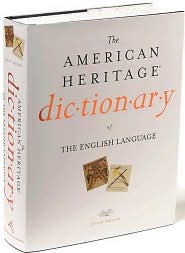This is an AWESOME multi-channel and multi-faceted campaign and a great example of print embracing the digital world as an added value!
A Dictionary Updated, and a Campaign to Spread the Word
By STUART ELLIOTT
 TRYING to sell a $60 print dictionary in 2011 is like trying to sell a silent movie.
TRYING to sell a $60 print dictionary in 2011 is like trying to sell a silent movie.
Wait …What’s that? The Weinstein Company is releasing “The Artist,” a modern-day silent movie, in theaters on Nov. 25?
O.K., how is this: Trying to sell a $60 print dictionary in 2011 is like trying to sell a print newspaper.
Wait …What’s that? Many people are reading this article in print newspapers?
Well, it goes to show, the line between the legacy media and the new media is not as finely drawn as some believe. That is particularly true in this instance, as Houghton Mifflin Harcourt begins a campaign to market the fifth edition of The American Heritage Dictionary of the English Language.
Executives at Houghton Mifflin Harcourt say they do not believe they will sell as many print copies of the new dictionary as they did of previous editions. That is why there is a free companion Web site for the dictionary, at ahdictionary.com. That is also why the dictionary is being made available as an app and for e-readers. (The app is free with the purchase of the print dictionary and $24.99 if bought separately. The app is published by Enfour, to which Houghton Mifflin Harcourt has licensed the rights. The e-reader version, from Houghton Mifflin Harcourt, has a suggested list price of $60.)
The executives also believe, however, that many consumers will still find value in owning a dictionary of more than 2,000 pages in book form, and the marketing campaign reflects that.
The campaign, scheduled to begin on Tuesday, has an estimated $300,000 budget. Most of the work is being created by Mechanica, an agency in Newburyport, Mass., and the rest by Verso Advertising in New York.
The campaign’s theme is “You are your words. Make the most of them.” In keeping with the interaction between the print and digital versions of the dictionary, the campaign has an extensive presence online as well as in print (newspapers and magazines) and on radio (sponsorship credits on NPR).
For instance, the theme is brought to life in a microsite, or special Web site, at youareyourwords.com, where computer users can create images composed of word clouds.
The dictionary also has its own Twitter handle, @ahdictionary. In recent days, people who have been using interesting words in their Twitter posts — among them, “belie” and “disingenuous” — have won free dictionaries.
The campaign was inspired by research conducted by Mechanica that showed surprising results, said Bruce Nichols, a senior vice president and publisher at Houghton Mifflin Harcourt in New York.
“You might think, if you had to guess, that there’s an old-fashioned slice of the market that wants a print dictionary and a younger, hipper slice that wants it digitally,” Mr. Nichols said. “But the audience most likely to buy the new edition in print is the same audience likely to consume it in multiple formats.”
“Our main target wants a print edition at home for the kids, to have a richer experience looking up words,” he added, “and they want it on their devices to have it everywhere.”
Continues at: A Dictionary Is Updated, and a Campaign Will Spread the Word – NYTimes.com.











